Feb 27, 2005: (PB photo).. adult male
http://www.flickr.com/photos/66339356@N00/1793151876/in/set-7215760277115 8045/

Feb 27, 2005: (PB photo).. adult male
http://www.flickr.com/photos/66339356@N00/1793151876/in/set-7215760277115 8045/
Louise Dickson
Times Colonist (Victoria)
26-Feb-2005
They’re harnessing the tide at Pearson College to keep the lights burning at Race Rocks.
Turbulent tides tumbling by Race Rocks ecological reserve near Metchosin will test how well a new tidal turbine generator stands up to the harsh West Coast environment.
Pearson, which brings together students from around the world for studies and to serve the community, expects the tides to help produce more than enough electricity to replace two diesel generators and provide power to the college’s marine education centre on Great Race Rock Island by 2006.
“The project, the first of its kind in Canada, could prove the value of new technology over time and it could be very beneficial to coastal peoples around the world,” Stuart Walker, director of Lester B. Pearson College of the Pacific, said Friday.
The $4-million project is a partnership between Pearson College, EnCana Corporation of Canada, and Clean Current Power Systems of Vancouver. EnCana, the largest producer and developer of natural gas in North America, is investing $3 million in the project from its environmental innovation fund.
Clean Current developed and built the prototype of a tidal turbine generator which harnesses the power of ocean currents to produce electricity.
Testing will take place in about 15 metres of water, off Race Rocks, about 10 nautical miles southwest of Victoria. The tidal turbine generator, which functions like an underwater windmill, will be anchored to the seabed, and cables will carry away the electricity it generates.
When the tide flows, the blades turn, explained Glen Darou, president of Clean Current. The blades have a permanent magnet attached to them. When the magnet passes by coils, the coils create electricity. The turbine works when currents are flowing in either direction.
According to Darou, the project will have minimal impact on the environment.
“We will have to disturb the bottom of the ocean with the turbine and cables but it’s a fast-growing marine en-
vironment and will recover quickly,” he said.
“Anything that can swim in the tidal currents will not swim into the turbine, it will swim around it. But something that floats through like a jellyfish could actually go into it. That’s the size of the risk.”
The prototype has been tested in fresh water, but Clean Current has to make sure its turbine generator works in saltwater.
“Now we have to prove its operability and maintenance,” said Darou.
Clean Current will know in about 18 months how the model and its one moving part — the rotor — stands up to corrosion in a harsh marine environment. The turbine will be monitored by underwater cameras. The prototype being tested is 3.5-metres in diameter and can produce enough electricity for 10 houses. Full scale models will be 14 metres in diameter and produce enough electricity for 250 houses.
Darou envisions the day when there will be big underwater tidal turbine generator farms with up to 800 turbines that will produce electricity around the world.
“The end of the dream will be our technology licensed around the world and applied in tidal environments all over the world. It’s seeing the technology used and replacing fossil fuels,” he said.
The project will run at Race Rocks for five years. After that, Clean Current will sell the prototype to either B.C. Parks or Pearson College for $1.
Clean Current still needs to come up with $1 million to pay for the project, Darou said. He expected the money will come from private investors and the federal government.
The project will help the company and the province evaluate the future of this technology, said B.C. Energy and Mines Minister Richard Neufeld.
Alternative energy will change how we consume fossil fuels over time, said Neufeld. “This is brand new, so let’s give it time to see how it works. Let’s give it time to see (how) technology can change it to make it more efficient.,” said Neufeld.
Tide Turns for Power, and for Young Minds: Pearson College, Partners Apply Current ThinkingTimes Colonist (Victoria)
Saturday, February 26, 2005 Page: A1 / FRONT Section: News Byline: Louise Dickson Source: Times Colonist
They’re harnessing the tide at Pearson College to keep the lights burning at Race Rocks. Turbulent tides tumbling by Race Rocks ecological reserve near Metchosin will test how well a new tidal turbine generator stands up to the harsh West Coast environment.
Pearson, which brings together students from around the world for studies and to serve the community, expects the tides to help produce more than enough electricity to replace two diesel generators and provide power to the college’s marine education centre on Great Race Rock Island by 2006. “The project, the first of its kind in Canada, could prove the value of new technology over time and it could be very beneficial to coastal peoples around the world,” Stuart Walker, director of Lester B. Pearson College of the Pacific, said Friday. The $4-million project is a partnership between Pearson College, EnCana Corporation of Canada, and Clean Current Power Systems of Vancouver. EnCana, the largest producer and developer of natural gas in North America, is investing $3 million in the project from its environmental innovation fund. Clean Current developed and built the prototype of a tidal turbine generator which harnesses the power of ocean currents to produce electricity. Testing will take place in about 15 metres of water, off Race Rocks, about 10 nautical miles southwest of Victoria. The tidal turbine generator, which functions like an underwater windmill, will be anchored to the seabed, and cables will carry away the electricity it generates.When the tide flows, the blades turn, explained Glen Darou, president of Clean Current. The blades have a permanent magnet attached to them. When the magnet passes by coils, the coils create electricity. The turbine works when currents are flowing in either direction. According to Darou, the project will have minimal impact on the environment. “We will have to disturb the bottom of the ocean with the turbine and cables but it’s a fast-growing marine environment and will recover quickly,” he said. “Anything that can swim in the tidal currents will not swim into the turbine, it will swim around it. But something that floats through like a jellyfish could actually go into it. That’s the size of the risk.” The prototype has been tested in fresh water, but Clean Current has to make sure its turbine generator works in saltwater. “Now we have to prove its operability and maintenance,” said Darou. Clean Current will know in about 18 months how the model and its one moving part — the rotor — stands up to corrosion in a harsh marine environment. The turbine will be monitored by underwater cameras. The prototype being tested is 3.5-metres in diameter and can produce enough electricity for 10 houses. Full scale models will be 14 metres in diameter and produce enough electricity for 250 houses. Darou envisions the day when there will be big underwater tidal turbine generator farms with up to 800 turbines that will produce electricity around the world. “The end of the dream will be our technology licensed around the world and applied in tidal environments all over the world. It’s seeing the technology used and replacing fossil fuels,” he said. The project will run at Race Rocks for five years. After that, Clean Current will sell the prototype to either B.C. Parks or Pearson College for $1. Clean Current still needs to come up with $1 million to pay for the project, Darou said. He expected the money will come from private investors and the federal government. The project will help the company and the province evaluate the future of this technology, said B.C. Energy and Mines Minister Richard Neufeld. Alternative energy will change how we consume fossil fuels over time, said Neufeld. “This is brand new, so let’s give it time to see how it works. Let’s give it time to see (how) technology can change it to make it more efficient.,” said Neufeld.
College Harnessing Waves to Power Ecological Reserve Okanagan Weekender Sunday, February 27, 2005 Page: A2 Section: West Byline: Dateline: VICTORIA Source: Canadian PressVICTORIA (CP) — They’re harnessing the tide at Pearson College on Vancouver Island to keep the lights burning at Race Rocks ecological reserve. Turbulent tides tumbling by Race Rocks will test how well a new tidal turbine generator stands up to the harsh west coast environment. The project is expected to produce more than enough electricity to replace two diesel generators and provide power to the suburban Metchosin college’s marine education centre on Great Race Rock Island by 2006. “The project, the first of its kind in Canada, could prove the value of new technology over time, and it could be very beneficial to coastal peoples around the world,” Stuart Walker, director of Lester B. Pearson College of the Pacific, said Friday. The $4-million project is a partnership between Pearson College, Calgary-based EnCana Corp., and Clean Current Power Systems of Vancouver. EnCana, the largest producer and developer of natural gas in North America, is investing $3 million in the project from its environmental innovation fund. Clean Current developed and built the prototype of a tidal turbine generator that harnesses the power of ocean currents to produce electricity. Testing will take place in about 15 metres of water, off Race Rocks, about 10 nautical miles southwest of Victoria. The tidal turbine generator, which functions like an underwater windmill, will be anchored to the seabed. When the tide flows, the blades turn. They have a permanent magnet attached that passes by coils, which create electricity. The electricity passes through a cable on the seabed into a facility where it is conditioned. The turbine works when currents are flowing in either direction.
College Reseachers Testing Tidal Power
B.C. news roundup: Feb. 26 Broadcast News Saturday, February 26, 2005
Pearson College near Victoria is testing the waters of tidal power with a new turbine generator to run the Race Rocks ecological preserve. It’s a $4 million experiment to see how well the new turbine stands up to the harsh west-coast environment. If it works, the unit will replace two diesel generators by March 2006. The project is being sponsored Calgary-based energy producer EnCana Corporation and Clean Current Power Systems of Vancouver.
Project tests Race Rocks’ Tidal Power
Goldstream News Gazette Mar 02 2005, By Rick Stiebel
The tides of change are turning in Metchosin. Lester B. Pearson College of the Pacific, Encana Corporation and Clean Current Power Systems announced an innovative partnership Friday to build a free-stream tidal power generator, the first of its kind in Canada, at the Race Rocks Ecological Reserve. The project, made possible by a $3 million investment from Encana’s Environmental Innovation Fund, involves replacing two diesel-powered generators at Race Rocks that supply power for Pearson’s marine education centre with a tidal turbine generator, built by Clean Current Power Systems. The remaining funding for the $4 million project is expected to come from private investors and the federal government. The generator is scheduled to begin producing power by 2006. The turbine generator has only one moving part, the rotor assembly that contains permanent magnets. The turbine, anchored to the ocean floor in about 15 metres of water, operates like an underwater windmill with cables that carry away the energy it produces. “This Canadian technology is simple, efficient and environmentally friendly,” Clean Current president Glen Darou said at the Feb. 25 announcement at Pearson College.
A prototype, which has been tested in fresh water, will be scrutinized closely over the next 18 months to see how it holds up to corrosion resulting from a marine, saltwater environment. “This is a terrific project for Pearson College, in that it supports our goal of making the ecological reserve a showcase for alternative, low impact technologies such as tidal power,” said Pearson College director Stuart Walker. Pearson College staff and students played a major role in having the site at Race Rocks, about three nautical miles from the Metchosin school. Race Rocks was declared an ecological reserve in 1980. The college is dedicated to protecting the marine ecosystems within the reserve, while increasing awareness about marine systems, ecological reserves and environmental issues, Walker said.
Encana Corporation CEO president Gwyn Morgan said his company is “pleased to be a partner in a first-class, alternative energy project.” “Our investment in this B.C. based unconventional environmental and power technology reflects our desire to tangibly encourage innovative energy solutions.” Encana is one of North America’s largest independent oil and natural gas companies, with an enterprise value of about $34 billion US.
B.C. Minister of Energy and Mines Richard Neufeld praised the three parties involved in the partnership.
“The project certainly looks environmentally sound,” said Don McLaren, area supervisor for B.C. Parks. “It will not only remove the diesel generators on Race Rocks, but greatly reduce the noise factor.” McLaren said the project will put Pearson College and B.C. Parks in “a greener position, and help us and Pearson a lot.”
See Below for entries from the :
Pearson, which brings together students from around the world for studies and to serve the community, expects the tides to help produce more than enough electricity to replace two diesel generators and provide power to the college’s marine education centre on Great Race Rock Island by 2006. “The project, the first of its kind in Canada, could prove the value of new technology over time and it could be very beneficial to coastal peoples around the world,” Stuart Walker, director of Lester B. Pearson College of the Pacific, said Friday. The $4-million project is a partnership between Pearson College, EnCana Corporation of Canada, and Clean Current Power Systems of Vancouver. EnCana, the largest producer and developer of natural gas in North America, is investing $3 million in the project from its environmental innovation fund. Clean Current developed and built the prototype of a tidal turbine generator which harnesses the power of ocean currents to produce electricity. Testing will take place in about 15 metres of water, off Race Rocks, about 10 nautical miles southwest of Victoria. The tidal turbine generator, which functions like an underwater windmill, will be anchored to the seabed, and cables will carry away the electricity it generates.When the tide flows, the blades turn, explained Glen Darou, president of Clean Current. The blades have a permanent magnet attached to them. When the magnet passes by coils, the coils create electricity. The turbine works when currents are flowing in either direction. According to Darou, the project will have minimal impact on the environment. “We will have to disturb the bottom of the ocean with the turbine and cables but it’s a fast-growing marine environment and will recover quickly,” he said. “Anything that can swim in the tidal currents will not swim into the turbine, it will swim around it. But something that floats through like a jellyfish could actually go into it. That’s the size of the risk.” The prototype has been tested in fresh water, but Clean Current has to make sure its turbine generator works in saltwater. “Now we have to prove its operability and maintenance,” said Darou. Clean Current will know in about 18 months how the model and its one moving part — the rotor — stands up to corrosion in a harsh marine environment. The turbine will be monitored by underwater cameras. The prototype being tested is 3.5-metres in diameter and can produce enough electricity for 10 houses. Full scale models will be 14 metres in diameter and produce enough electricity for 250 houses. Darou envisions the day when there will be big underwater tidal turbine generator farms with up to 800 turbines that will produce electricity around the world. “The end of the dream will be our technology licensed around the world and applied in tidal environments all over the world. It’s seeing the technology used and replacing fossil fuels,” he said. The project will run at Race Rocks for five years. After that, Clean Current will sell the prototype to either B.C. Parks or Pearson College for $1. Clean Current still needs to come up with $1 million to pay for the project, Darou said. He expected the money will come from private investors and the federal government. The project will help the company and the province evaluate the future of this technology, said B.C. Energy and Mines Minister Richard Neufeld. Alternative energy will change how we consume fossil fuels over time, said Neufeld. “This is brand new, so let’s give it time to see how it works. Let’s give it time to see (how) technology can change it to make it more efficient.,” said Neufeld.
Tide Turns for Power, and for Young Minds: Pearson College, Partners Apply Current Thinking Times Colonist (Victoria) Saturday, February 26, 2005 Page: A1 / FRONT Section: News Byline: Louise Dickson Source: Times Colonist<They’re harnessing the tide at Pearson College to keep the lights burning at Race Rocks. Turbulent tides tumbling by Race Rocks ecological reserve near Metchosin will test how well a new tidal turbine generator stands up to the harsh West Coast environment.
College Harnessing Waves to Power Ecological Reserve Okanagan Weekender Sunday, February 27, 2005 Page: A2 Section: West Byline: Dateline: VICTORIA Source: Canadian Press VICTORIA (CP) — They’re harnessing the tide at Pearson College on Vancouver Island to keep the lights burning at Race Rocks ecological reserve. Turbulent tides tumbling by Race Rocks will test how well a new tidal turbine generator stands up to the harsh west coast environment. The project is expected to produce more than enough electricity to replace two diesel generators and provide power to the suburban Metchosin college’s marine education centre on Great Race Rock Island by 2006. “The project, the first of its kind in Canada, could prove the value of new technology over time, and it could be very beneficial to coastal peoples around the world,” Stuart Walker, director of Lester B. Pearson College of the Pacific, said Friday. The $4-million project is a partnership between Pearson College, Calgary-based EnCana Corp., and Clean Current Power Systems of Vancouver. EnCana, the largest producer and developer of natural gas in North America, is investing $3 million in the project from its environmental innovation fund. Clean Current developed and built the prototype of a tidal turbine generator that harnesses the power of ocean currents to produce electricity. Testing will take place in about 15 metres of water, off Race Rocks, about 10 nautical miles southwest of Victoria. The tidal turbine generator, which functions like an underwater windmill, will be anchored to the seabed. When the tide flows, the blades turn. They have a permanent magnet attached that passes by coils, which create electricity. The electricity passes through a cable on the seabed into a facility where it is conditioned. The turbine works when currents are flowing in either direction.
CollegeReseachers Testing Tidal Power B.C. news roundup: Feb. 26 Broadcast News Saturday, February 26, 2005Pearson College near Victoria is testing the waters of tidal power with a new turbine generator to run the Race Rocks ecological preserve. It’s a $4 million experiment to see how well the new turbine stands up to the harsh west-coast environment. If it works, the unit will replace two diesel generators by March 2006. The project is being sponsored Calgary-based energy producer EnCana Corporation and Clean Current Power Systems of Vancouver.
Project tests Race Rocks’ Tidal Power Goldstream News Gazette Mar 02 2005, By Rick Stiebel The tides of change are turning in Metchosin. Lester B. Pearson College of the Pacific, Encana Corporation and Clean Current Power Systems announced an innovative partnership Friday to build a free-stream tidal power generator, the first of its kind in Canada, at the Race Rocks Ecological Reserve. The project, made possible by a $3 million investment from Encana’s Environmental Innovation Fund, involves replacing two diesel-powered generators at Race Rocks that supply power for Pearson’s marine education centre with a tidal turbine generator, built by Clean Current Power Systems. The remaining funding for the $4 million project is expected to come from private investors and the federal government. The generator is scheduled to begin producing power by 2006. The turbine generator has only one moving part, the rotor assembly that contains permanent magnets. The turbine, anchored to the ocean floor in about 15 metres of water, operates like an underwater windmill with cables that carry away the energy it produces. “This Canadian technology is simple, efficient and environmentally friendly,” Clean Current president Glen Darou said at the Feb. 25 announcement at Pearson College.
A prototype, which has been tested in fresh water, will be scrutinized closely over the next 18 months to see how it holds up to corrosion resulting from a marine, saltwater environment. “This is a terrific project for Pearson College, in that it supports our goal of making the ecological reserve a showcase for alternative, low impact technologies such as tidal power,” said Pearson College director Stuart Walker. Pearson College staff and students played a major role in having the site at Race Rocks, about three nautical miles from the Metchosin school. Race Rocks was declared an ecological reserve in 1980. The college is dedicated to protecting the marine ecosystems within the reserve, while increasing awareness about marine systems, ecological reserves and environmental issues, Walker said.
Encana Corporation CEO president Gwyn Morgan said his company is “pleased to be a partner in a first-class, alternative energy project.” “Our investment in this B.C. based unconventional environmental and power technology reflects our desire to tangibly encourage innovative energy solutions.” Encana is one of North America’s largest independent oil and natural gas companies, with an enterprise value of about $34 billion US.
B.C. Minister of Energy and Mines Richard Neufeld praised the three parties involved in the partnership. “The project certainly looks environmentally sound,” said Don McLaren, area supervisor for B.C. Parks. “It will not only remove the diesel generators on Race Rocks, but greatly reduce the noise factor.” McLaren said the project will put Pearson College and B.C. Parks in “a greener position, and help us and Pearson a lot.”

THE PEARSON COLLEGE-ENCANA-CLEAN CURRENT TIDAL POWER DEMONSTRATION PROJECT AT RACE ROCKS ANNOUNCEMENT FEB 25, 2005
TV: CH News Channel Coverage of the Event
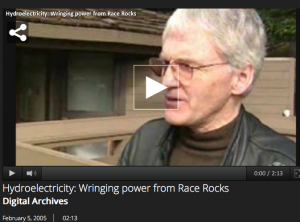 CBC Coverage: Wringing Power From Race Rocks
CBC Coverage: Wringing Power From Race Rocks
On February 25, 2005, Pearson College hosts the announcement of the Pearson College, ENCANA, Clean Current Tidal Power Demonstration Project at Race Rocks.
This video by Alexander Mirzoyan ( yr 31) (Russia) presents the complete proceedings and speeches. Pearson College Director Stewart Walker leads off with introductions to the speakers
The Provincial Ministry of Energy and Mines. Assisted with funding for the installation of solar panels and instrumentation for the Tidal Energy project.
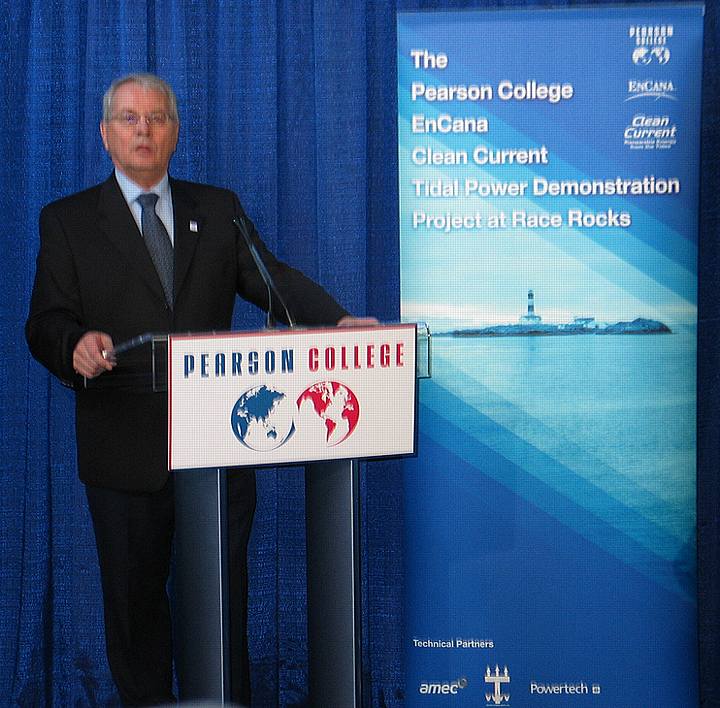
Minister Neufeld Speaks at the launch of the Lester Pearson College ENCANA Clean Current Tidal Energy Demonstration Project in February, 2005
“The commitment by Premier Campbell in promoting alternative energy sources has helped British Columbia become a world leader in sustainable environmental management,” said Neufeld. “The province commends projects like this one, as they show our commitment to developing clean energy solutions that will benefit all British Columbians.” The multi-year demonstration project will involve the installation, operation and monitoring of a 65kW free-stream tidal turbine generator in the water near Race Rocks, a provincial ecological reserve located 10 nautical miles southwest of Victoria..
Full video coverage of the event
| PRESS RELEASE below……February 25, 2005 (Link to PDF version)- ENCANA PARTNERS TO ENABLE PEARSON COLLEGE – ENCANA – CLEAN CURRENT TIDAL POWER DEMONSTRATION PROJECT AT RACE ROCKS, BC Victoria – Thanks to an innovative partnership between Lester B. Pearson College of the Pacific,EnCana Corporation and Clean Current Power Systems Incorporated, Canada’s first free-stream tidal power project will be built at the Race Rocks Ecological Reserve, offshore of Vancouver Island in British Columbia. The project will enable the world famous marine park to tap into surrounding ocean currents and convert tidal energy to electric power for its needs beginning in early 2006. Making the announcement were: Gwyn Morgan, President and CEO of EnCana, Glen Darou, President and CEO of Clean Current, Richard Neufeld, British Columbia Minister of Energy and Mines, and Stuart Walker, Director of Pearson College. 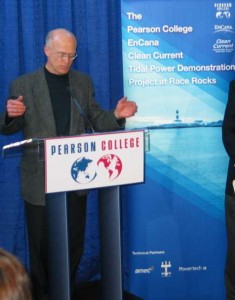 Officially known as the “Pearson College – EnCana – Clean Current Tidal Power Demonstration Project at Race Rocks,” the project is enabled by a $3-million investment from the EnCana Environmental Innovation Fund.“EnCana is pleased to be a partner in this first-class, alternative energy project,” said Morgan. “Our investment in this B.C.-based unconventional environmental and power technology reflects our desire to tangibly encourage innovative energy solutions.” EnCana’s Environmental Innovation Fund was established to advance new technologies and solutions that improve environmental performance associated with consuming and producing energy. Commercial proceeds from financed projects will be re-invested into the fund to ensure their sustainability. Officially known as the “Pearson College – EnCana – Clean Current Tidal Power Demonstration Project at Race Rocks,” the project is enabled by a $3-million investment from the EnCana Environmental Innovation Fund.“EnCana is pleased to be a partner in this first-class, alternative energy project,” said Morgan. “Our investment in this B.C.-based unconventional environmental and power technology reflects our desire to tangibly encourage innovative energy solutions.” EnCana’s Environmental Innovation Fund was established to advance new technologies and solutions that improve environmental performance associated with consuming and producing energy. Commercial proceeds from financed projects will be re-invested into the fund to ensure their sustainability.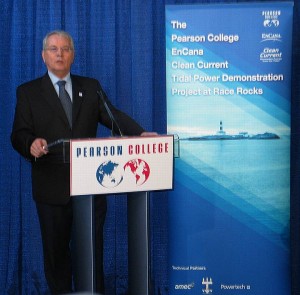 “The commitment by Premier Campbell in promoting alternative energy sources has helped British Columbia become a world leader in sustainable environmental management,” said Neufeld. “The province commends projects like this one, as they show our commitment to developing clean energy solutions that will benefit all British Columbians.” The multi-year demonstration project will involve the installation, operation and monitoring of a 65kW free-stream tidal turbine generator in the water near Race Rocks, a provincial ecological reserve located 10 nautical miles southwest of Victoria. “The commitment by Premier Campbell in promoting alternative energy sources has helped British Columbia become a world leader in sustainable environmental management,” said Neufeld. “The province commends projects like this one, as they show our commitment to developing clean energy solutions that will benefit all British Columbians.” The multi-year demonstration project will involve the installation, operation and monitoring of a 65kW free-stream tidal turbine generator in the water near Race Rocks, a provincial ecological reserve located 10 nautical miles southwest of Victoria.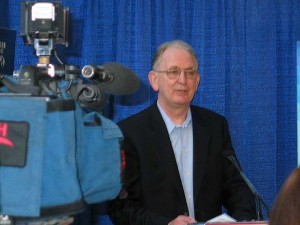 Clean Current is a private British Columbia-based company that designs and licenses technology that efficiently converts the energy of tidal currents into electricity. Clean Current’s proprietary technology consists of a horizontal-axis ducted turbine with a direct-drive variable speed permanent magnet generator. The turbine generator is equally efficient in both directions as the tidal currents reverse twice each day.“This Canadian technology is simple, efficient and environmentally friendly,” said Darou. “We believe it is highly exportable technology, with strong potential to succeed in international settings. Our company is delighted to have the support of EnCana, Pearson College, and technical partners AMEC, Powertech Labs Inc. and Triton Consultants Ltd.”Pears Clean Current is a private British Columbia-based company that designs and licenses technology that efficiently converts the energy of tidal currents into electricity. Clean Current’s proprietary technology consists of a horizontal-axis ducted turbine with a direct-drive variable speed permanent magnet generator. The turbine generator is equally efficient in both directions as the tidal currents reverse twice each day.“This Canadian technology is simple, efficient and environmentally friendly,” said Darou. “We believe it is highly exportable technology, with strong potential to succeed in international settings. Our company is delighted to have the support of EnCana, Pearson College, and technical partners AMEC, Powertech Labs Inc. and Triton Consultants Ltd.”Pears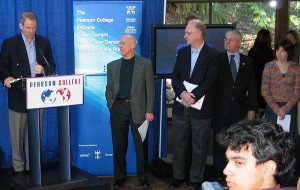 on College, one of ten United World Colleges worldwide, is the custodian of the Race Rocks Ecological Reserve, located three nautical miles from campus. Diesel-powered generators currently provide electricity requirements at the reserve. Students and staff will work elements of the tidal power demonstration project into their studies.“This is a terrific project for Pearson College, in that it supports our goal of making the ecological reserve a showcase for alternative, low-impact technologies such as tidal power,” said Walker. “We would like to thank Clean Current for their commitment to developing the technology and EnCana for the financial support that is making this demonstration project possible.” on College, one of ten United World Colleges worldwide, is the custodian of the Race Rocks Ecological Reserve, located three nautical miles from campus. Diesel-powered generators currently provide electricity requirements at the reserve. Students and staff will work elements of the tidal power demonstration project into their studies.“This is a terrific project for Pearson College, in that it supports our goal of making the ecological reserve a showcase for alternative, low-impact technologies such as tidal power,” said Walker. “We would like to thank Clean Current for their commitment to developing the technology and EnCana for the financial support that is making this demonstration project possible.”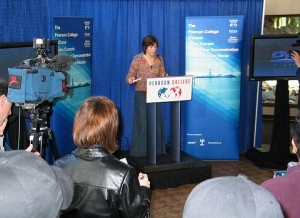 Second Year Pearson College student Alyssa Holland (year 30) concluded the presentation , by thanking the speakers. As a student involved in Environmental Systems and the diving program, she shared the enthusiasm she has for the resources of the area and emphasized the great importance she and other students attach to the effort of those involved in this project in the ongoing goal of producing energy sustainably.Below is the complete version of her speach: Second Year Pearson College student Alyssa Holland (year 30) concluded the presentation , by thanking the speakers. As a student involved in Environmental Systems and the diving program, she shared the enthusiasm she has for the resources of the area and emphasized the great importance she and other students attach to the effort of those involved in this project in the ongoing goal of producing energy sustainably.Below is the complete version of her speach:
BACKGROUNDER: (Link to PDF version)Race Rocks is a unique ecosystem located at the eastern entrance to the Strait of Juan de Fuca, three nautical miles from Pearson College and ten nautical miles southwest of Victoria, BC. The rocky outcroppings that form the Race Rocks group of islands are the visible summit of an underwater mountain and are washed daily by tidal currents that can run at up to seven knots. These swift waters are the lifeblood of breathtakingly diverse plant and animal life – recognized internationally as a treasured ecosystem. To First Nations people, Race Rocks was a banquet table in the swift flowing waters known to them as XwaYen. To early mariners it was a formidable hazard to be avoided. To fishers it was a haven for finding rockfish and halibut. To scuba divers it is an underwater paradise with thriving colonies of marine organisms. To generations of future researchers, college students and school children, it will be an awe-inspiring outdoor and virtual classroom. Additional information on Race Rocks is available at: www.racerocks.ca Lester B. Pearson College of the Pacific EnCana EnCana Environmental Innovation Fund The EnCana Environmental Innovation Fund (the Fund) supports these goals by lending financial support toward the development and commercialization of innovative new technologies and practices that create solutions to the environmental issues facing the energy sector. The fund is designed to invest in both external and internal projects that:
Targeted areas include air emission reductions, water conservation, renewable energy, and energy-efficiency improvements. To date, four projects have been financed, including a hybrid electric vehicle demonstration, a water recycling project, a drill cutting recycling facility and a renewable energy project. The Fund became operational in January 2004 and is currently reviewing candidate projects. Clean Current Power Systems Incorporated Efficiency and operability in salt water are the key ingredients of a successful tidal technology. Clean Current’s tidal turbine generator is a bi-directional ducted horizontal axis turbine with a direct drive variable speed permanent magnet generator. This proprietary design delivers better than 50 per cent water-to-wire efficiency, a significant improvement over competing free stream tidal energy technologies. Operability is enhanced by a simple design that has one moving part – the rotor assembly that contains the permanent magnets. There is no drive shaft and no gearbox. The turbine generator has a design life of 10 years (major overhaul every 10 years) and a service life of 25-30 years. During that time it will generate electricity with zero emissions, a minimal footprint on the bottom of the ocean and negligible impact on marine life. To ensure success Clean Current has enlisted the assistance of technical partners AMEC Americas Limited and AMEC Dynamic Structures Limited (both subsidiaries of AMEC PLC),Powertech, (a subsidiary of BC Hydro) and Triton Consultants Ltd. |
||||||||||||
Videoclips from. the following TV News Channels have been assembled here by Gerald Kasegar PC YR 21, and Alex Chan PC Yr. 31
CH NEWS –CBC News–VI News –CTV News
Text of speech by Alyssa Holland (year 30)
Tidal Current Energy Demonstration Project: Renewable Energy for Race Rocks
As I am both an Environmental Systems student and a member of the diving activity, Race Rocks has played a central role in the education Pearson has given me. Race Rocks is truly the ultimate living classroom, teaching all those who interact with it about the beauty and wonder of the natural environment, and about the importance of responsible environmental stewardship. It is a very special place that gives so much to the college and its students, and it is very gratifying to think how much the ecosystem will benefit from the Clean Current project.
For Pearson students, Race Rocks is much more than a group of islands. On one level or another, we all interact with it and benefit from it, and consider it part of our home. Whether through poking around in the inter-tidal zone for class, or working with a researcher from the University of Victoria 10 metres underwater, or staying on the island for a weekend to give its 2 full-time residents a break, we have built a connection with this magical place. As such, ensuring its health and protection are very important to me, and to the student body as a whole.
Pearson is by its very nature an innovative place – even the concept of a United World College is radical and still experimental. I can think of no better or more appropriate environment for such an exciting new technology as this to be implemented, as it truly embodies the spirit of innovation and idealism that makes Pearson College unique. This new turbine will stand as much more than a symbol of scientific progress; it will also be a concrete demonstration that even an ideal as difficult to live by as environmentalism can be successfully put into practice when we are innovative. That will be a lesson to guide both students and visitors for years to come.
Thanks to an innovative partnership between Lester B. Pearson College of the Pacific, EnCana Corporation and Clean Current Power Systems Incorporated, Canada’s first free-stream tidal power project will be built at the Race Rocks Ecological Reserve, offshore of Vancouver Island in British Columbia. The project will enable the world famous marine park to tap into surrounding ocean currents and convert tidal energy to electric power for its needs beginning in early 2006. Making the announcement were:
Gwyn Morgan, President and CEO of EnCana,
Glen Darou, President and CEO of Clean Current,
Richard Neufeld, British Columbia Minister of Energy and Mines,
and Stuart Walker, Director of Pearson College.
See the press release and pictures. http://www.racerocks.com/racerock/energy/tidalenergy/tidalenergyannounce.htm